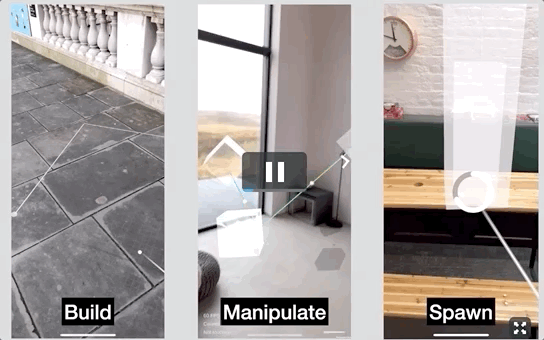Nat Martin and his team have created an AR controller that is sparking a lot of interest with big tech companies.
Nat Martin received a lot of attention in 2017 when Tech Insider released a video showing how Martin re-imagined the way you could interact with AR through a device he called a Scroll ring, a device he created when he was a student at the Royal College of Arts.
His innovative design allowed you to interact within your AR environment without having to place your hand in a certain position or perfect a specific gesture within the field of view on your headset sensors – and with a simple tap on the side of the ring, or thumb swipe, you were able to scroll through and control entire AR user-interfaces.
Since that video, Martin’s Scroll ring has gone through several iterations and has evolved into something that no longer looks like a ring; instead, it has morphed into an interesting-looking interactive wearable called LITHO, that promises a more dynamic, intuitive, and precise mobile AR experience.
Where the Scroll ring was a merer prototype that required the ring to be tethered to a computer, LITHO is an untethered, finger-worn controller that connects to your smartphone or headset via Bluetooth and has a touch surface on the underside.
The alluring device has an array of motion-tracking sensors that include accelerometers, gyroscopes, and magnetometers that weigh 16g; capable of sub-millimeter precision with 4 hours of usage, 1,000 hours of standby, and charges in 90 minutes.
Also captivating about LITHO is its ability to be used in a VR environment through a VR Mode that offers you all the same controls you would have in an AR environment. This means being able to build, manipulate, navigate, spawn digital objects using only your hand. You could even control things such as your thermostat and dim the lights in your house with a simple hand motion.
To bring LITHO to life, Martin brought on his two friends from high school, Charlie Bruce (Head of Hardware) and Lewis Jones (Head of Software), as partners in their newly established company, just recently expanding the team with the addition of Maya Hope (who manages dev relations and handles recruiting as Head of People). This team of young innovators already have a number of well-established leading tech companies and organizations deeply curious about their AR projects.

Martin and his team / Image Credit: LITHO
In an interview with VRScout, Martin talked about his first AR experience, LITHO and the future of AR.
“I was a sciency kid,” said Martin, “but unlike American universities where students are able to pick a major and a minor, or can even double major – the UK education system is a bit more traditional where students study either physics or history.” There wasn’t a lot of options for Martin to explore his science side, but it was by chance that he stumbled across one class that showed promise. “I always wanted to be an inventor, and this course let you do that – you could build whatever you wanted, it was output focused, and the idea of the class was to design new products.”
It was here that Martin was first exposed to augmented reality. The school purchased a Microsoft HoloLens that students could sign out like a library book and take it home for a week. “The first thing I did was play RoboRaid, and I was impressed with the UI and how people could move and interact with objects in AR.”
As impressed as Martin was with the HoloLens, he always thought the interaction with AR objects could be better; more “delightful and intuitive.”

Image Credit: LITHO
For example, in order to move objects using Microsoft’s HoloLens, you need to master various hand gestures such as a ‘bloom’ or ‘tap’, and according to Microsoft themselves, the AR headset requires you to “place your hand in the field of view in the ready position.”
If you’ve ever used a HoloLens, then you know – the hand placement alone can be a bit awkward and even tiring.
“It just didn’t feel natural,” said Martin. Even Microsoft acknowledged this during the recent announcement of their HoloLens 2; part of their presentation was dedicated to how they worked hard to improve the hand gestures that you would use to control an AR environment.
As for the future of AR, the possibilities are limitless. Martin explains, “it’s going to be a longer and more complicated road where a lot of ideas will be explored,” adding, “spatial computing is heading towards this idea of hyper-reality (HR), which can be a lot of information all at once.”
With more and more apps using your location along with your camera’s depth sensors, and software such as ARKit and ARCore becoming more prevalent among developers, there’s no doubt we are moving closer to information overload. The LITHO team sees their wearable AR device as a solution for this eventual onslaught of information.
As Martin explains, “you could just walk up to the bus stop and with a simple tap on LITHO, the bus schedule would just pop up in front of you in your glasses or as information on your smart device, or you could turnaround and point towards a shop and ask what time will the shop close, and the information is delivered through a visual AR notification or through audio.”
If you are interested in this hardware, you can apply for their beta program which is open to selected developers and strategic partners. The initiative will give you early access to the LITHO controller and the LITHO SDK for $199.
The first batch of devices ship out later this month to approved testers.
The post Nat Martin Wants To Change The Way You Interact With AR Environments appeared first on VRScout.